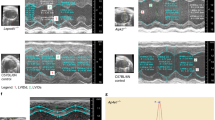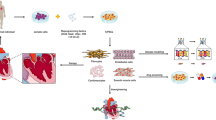Abstract
Embryonic stem cell (ESC) research is a promising area of investigation with enormous therapeutic potential. We have injected murine wild type (WT) ESCs into a variety of mutant murine blastocysts, which are predisposed to develop a human-like disease, such as muscular dystrophy or the embryonic lethal “thin myocardial syndrome”. In this review, we summarize data indicating that partial incorporation of ESCs is sufficient to prevent disease from occurring. We also present data indicating that blastocyst incorporation of ESCs may aid in the prevention of heart failure in stressed WT mice. In some cases, the rescue observed is predominantly non-cell autonomous and relies on the production of secreted factors from the ES-derived cells, but in others, cell replacement is required. Thus, congenital or acquired disease can be pre-emptively averted in mice by developmental injection of ESCs.




Similar content being viewed by others
References
Odorico, J. S., Kaufman, D. S., & Thomson, J. A. (2001). Multilineage differentiation from human embryonic stem cell lines. Stem Cells, 19(3), 193–204.
Laflamme, M. A., & Murry, C. E. (2005). Regenerating the heart. Nature Biotechnology, 23(7), 845–856.
Rossant, J. (2008). Stem cells and early lineage development. Cell, 132(4), 527–531.
Murry, C. E., & Keller, G. (2008). Differentiation of embryonic stem cells to clinically relevant populations: lessons from embryonic development. Cell, 132(4), 661–680.
Chien, K. R., Moretti, A., & Laugwitz, K. L. (2004). Development. ES cells to the rescue. Science, 306(5694), 239–240.
Ruzinova, M. B., & Benezra, R. (2003). Id proteins in development, cell cycle and cancer. Trends in Cell Biology, 13(8), 410–418.
Jen, Y., Manova, K., & Benezra, R. (1996). Expression patterns of Id1, Id2, and Id3 are highly related but distinct from that of Id4 during mouse embryogenesis. Developmental Dynamics, 207(3), 235–252.
Jen, Y., Manova, K., & Benezra, R. (1997). Each member of the Id gene family exhibits a unique expression pattern in mouse gastrulation and neurogenesis. Developmental Dynamics, 208(1), 92–106.
Fraidenraich, D., Stillwell, E., Romero, E., et al. (2004). Rescue of cardiac defects in id knockout embryos by injection of embryonic stem cells. Science, 306(5694), 247–252.
Fraidenraich, D., & Benezra, R. (2006). Embryonic stem cells prevent developmental cardiac defects in mice. Nature Clinical Practice Cardiovascular Medicine, 3(Suppl 1), S14–S17.
Powell-Braxton, L., Hollingshead, P., Warburton, C., et al. (1993). IGF-I is required for normal embryonic growth in mice. Genes and Development, 7(12B), 2609–2617.
Powell-Braxton, L., Hollingshead, P., Giltinan, D., Pitts-Meek, S., & Stewart, T. (1993). Inactivation of the IGF-I gene in mice results in perinatal lethality. Annals of the New York Academy of Sciences, 692, 300–301.
Liu, J. P., Baker, J., Perkins, A. S., Robertson, E. J., & Efstratiadis, A. (1993). Mice carrying null mutations of the genes encoding insulin-like growth factor I (Igf-1) and type 1 IGF receptor (Igf1r). Cell, 75(1), 59–72.
Cadigan, K. M., & Nusse, R. (1997). Wnt signaling: a common theme in animal development. Genes and Development, 11(24), 3286–3305.
Oishi, I., Suzuki, H., Onishi, N., et al. (2003). The receptor tyrosine kinase Ror2 is involved in non-canonical Wnt5a/JNK signalling pathway. Genes Cells, 8(7), 645–654.
Schneider, V. A., & Mercola, M. (2001). Wnt antagonism initiates cardiogenesis in Xenopus laevis. Genes and Development, 15(3), 304–315.
Hoffman, E. P., Brown, R. H., Jr., & Kunkel, L. M. (1987). Dystrophin: the protein product of the Duchenne muscular dystrophy locus. Cell, 51(6), 919–928.
Stedman, H. H., Sweeney, H. L., Shrager, J. B., et al. (1991). The mdx mouse diaphragm reproduces the degenerative changes of Duchenne muscular dystrophy. Nature, 352(6335), 536–539.
Durbeej, M., & Campbell, K. P. (2002). Muscular dystrophies involving the dystrophin-glycoprotein complex: an overview of current mouse models. Current Opinion in Genetics and Development, 12(3), 349–361.
Stillwell, E., Vitale, J., Zhao, Q., et al. (2009). Blastocyst injection of wild type embryonic stem cells induces global corrections in mdx mice. PLoS ONE, 4(3), e4759.
Hardiman, O. (1994). Dystrophin deficiency, altered cell signalling and fibre hypertrophy. Neuromuscular Disorders, 4(4), 305–315.
Peault, B., Rudnicki, M., Torrente, Y., et al. (2007). Stem and progenitor cells in skeletal muscle development, maintenance, and therapy. Molecular Therapy, 15(5), 867–877.
Walsh, K. (2009). Adipokines, myokines and cardiovascular disease. Circulation Journal, 73(1), 13–18.
Low, H. P., Greco, B., Tanahashi, Y., et al. (2009). Embryonic stem cell rescue of tremor and ataxia in myelin-deficient shiverer mice. Journal of the Neurological Sciences, 276(1–2), 133–137.
Bergmann, O., Bhardwaj, R. D., Bernard, S., et al. (2009). Evidence for cardiomyocyte renewal in humans. Science, 324(5923), 98–102.
Terzic, A., Moore, R. L., & Waldman, S. A. (2007). Acquired and innate cardioprotection. Journal of Applied Physiology, 103(4), 1436–1437.
Yamada, S., Nelson, T. J., Behfar, A., Crespo-Diaz, R. J., Fraidenraich, D., & Terzic, A. (2009). Stem cell transplant into preimplantation embryo yields myocardial infarction-resistant adult phenotype. Stem Cells, 27(7), 1697–1705.
Nelson, T. J., Martinez-Fernandez, A., & Terzic, A. (2009). KCNJ11 knockout morula re-engineered by stem cell diploid aggregation. Philosophical Transactions of the Royal Society of London. Series B, Biological Sciences, 364(1514), 269–276.
Takahashi, K., Tanabe, K., Ohnuki, M., et al. (2007). Induction of pluripotent stem cells from adult human fibroblasts by defined factors. Cell, 131(5), 861–872.
Rodolfa, K. T., & Eggan, K. (2006). A transcriptional logic for nuclear reprogramming. Cell, 126(4), 652–655.
Yu, J., Vodyanik, M. A., Smuga-Otto, K., et al. (2007). Induced pluripotent stem cell lines derived from human somatic cells. Science, 318(5858), 1917–1920.
Meissner, A., Wernig, M., & Jaenisch, R. (2007). Direct reprogramming of genetically unmodified fibroblasts into pluripotent stem cells. Nature Biotechnology, 25(10), 1177–1181.
Soldner, F., Hockemeyer, D., Beard, C., et al. (2009). Parkinson’s disease patient-derived induced pluripotent stem cells free of viral reprogramming factors. Cell, 136(5), 964–977.
Park, I. H., Arora, N., Huo, H., et al. (2008). Disease-specific induced pluripotent stem cells. Cell, 134(5), 877–886.
Freund, C., & Mummery, C. L. (2009). Prospects for pluripotent stem cell-derived cardiomyocytes in cardiac cell therapy and as disease models. Journal of Cellular Biochemistry, 107(4), 592–599.
Acknowledgments
We thank Dr. Robert Benezra (Memorial Sloan-Kettering Cancer Center) for support with initial studies. This work was supported by the National Institutes of Health (D.F., A.T.), American Heart Association (D.F.), Muscular Dystrophy Association (D.F.), New Jersey Commission on Science and Technology (D.F.), UMDNJ Foundation (D.F.), American Society for Clinical Pharmacology and Therapeutics (A.T.), Marriott Heart Disease Research Program (A.T.), Marriott Foundation (A.T.), Ted Nash Long Life Foundation (A.T.), Ralph Wilson Medical Research Foundation (A.T.), and Mayo Clinic Clinician-Investigator Program (A.T.).
Author information
Authors and Affiliations
Corresponding author
Additional information
Joel S. Schneider and Joseph M. Vitale contributed equally to this work
Rights and permissions
About this article
Cite this article
Schneider, J.S., Vitale, J.M., Terzic, A. et al. Blastocyst Injection of Embryonic Stem Cells: A Simple Approach to Unveil Mechanisms of Corrections in Mouse Models of Human Disease. Stem Cell Rev and Rep 5, 369–377 (2009). https://doi.org/10.1007/s12015-009-9089-6
Received:
Accepted:
Published:
Issue Date:
DOI: https://doi.org/10.1007/s12015-009-9089-6




